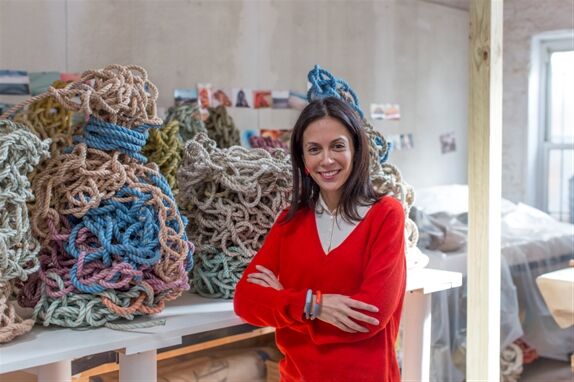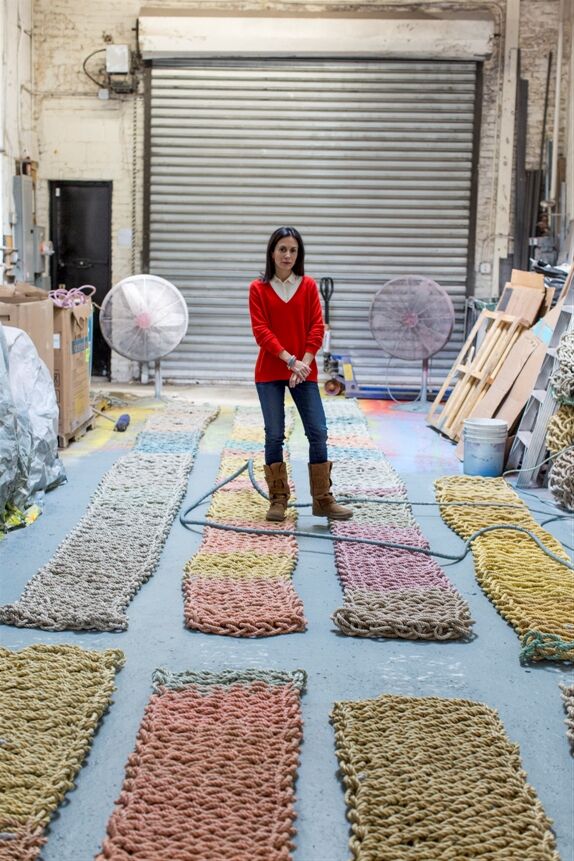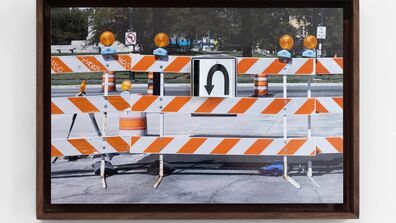
Shaping Spaces

by Jessica Barrett Sattell (MA 2015)
The work of Orly Genger (Post-Bac 2002) is both robust and delicate, a mesh of interwoven strands evoking powerful statements on the notion of space. The New York-based artist—known for her large-scale installations constructed from hand-crocheted rope, shaped, and painted into fields of color that twist into landscapes—has work in the collections of the Museum of Modern Art (MoMA) and the Whitney Museum of American Art, among many others. Merging large-scale with handmade, a single one of those pieces takes months to create, employing a performative, physically demanding process of knotting and weaving. When complete and placed in a public sphere, it invites interactivity and community conversation.
Born and raised in New York, Genger came to SAIC after finishing her undergraduate work at Brown University, having heard that the school would provide her a different approach to continuing her art-making practice. While she describes her year as a post-baccalaureate student in sculpture as a “challenging” one that encouraged her to deeply consider the thought process behind what she was making, she emerged feeling more confident being able to describe the driving themes and issues in her work.
“My time at SAIC pushed me to stop and think about what I was making, and to try to verbalize it, by trying to find connections—why I kept constantly doing something, or why something kept showing up over and over. It made me really pay attention to what I was making,” she says.
While at SAIC she picked up hand-crocheting, a process she has now been working with for more than 10 years. She started by making small sculptural pieces out of yarn and collected them, eventually deciding to connect them together into a larger piece.
“In class, we discussed the surprising element of how muscular that piece was, and I started to become interested in the idea of how I could make sculpture out of that material,” she says. “I could deal with issues that I was trying to before—[having the work] take up space, and all of these kinds of traditional ideas of sculpture.”
After Genger finished her studies at SAIC and returned to New York, she continued to employ hand-crocheting in her work, soon encountering the opportunity to exhibit a piece outdoors for the first time in 2004 at Socrates Sculpture Park. For that installation, she abandoned wool yarn for a material that could withstand the elements: climbing rope.
“I fell in love with the heft of it,” she says. “That was the first time that I became interested in something that was much more substantial in both weight and size.” From there, it has grown to an even larger scale; she now utilizes recycled lobster-fishing rope.

While Genger also makes smaller-scale work to be displayed in galleries and museums, many are more familiar with her large-scale public installations constructed from layers of knotted strips of rope and sculpted into winding forms, such as Hot Rod (2013) at the Chicago lakefront and Red, Yellow, and Blue (2013) in New York’s Madison Square Park. The materiality of such pieces is looming, but still approachable—soft, but still retaining the characteristics of the great amount of physical labor involved in their fabrication and construction.
While the location and audience change for each installation, Genger’s consistent excitement for showing her work in public comes from the fact that many of her viewers will encounter it upon happenstance, or en route to another destination. She aims to ultimately affect the movement of people passing through the installation site, meshing the forms of her sculptures with the landscapes.
“When I make work for outdoor spaces, it’s usually geared towards public involvement or interaction, so that people can feel like they aren’t looking at something that is on a pedestal or is separate from them, but that it’s a sculpture that integrates the space that they’re in,” she explains. “The sculpture becomes part of the space, rather than just something that was dropped there. It’s made for people to interact with it.”
